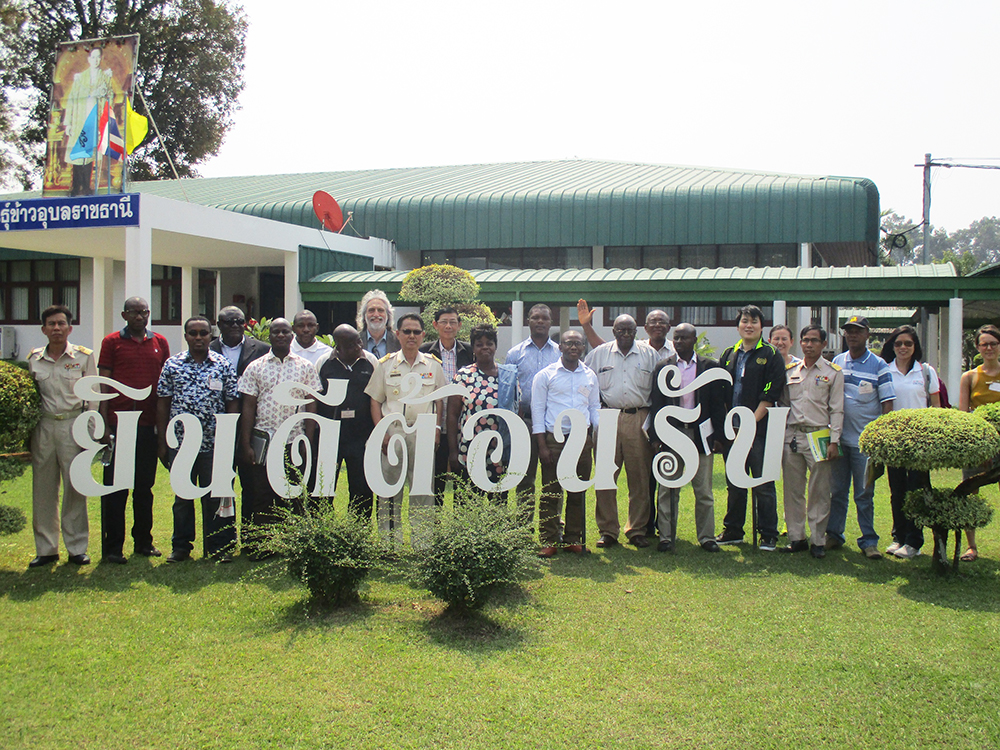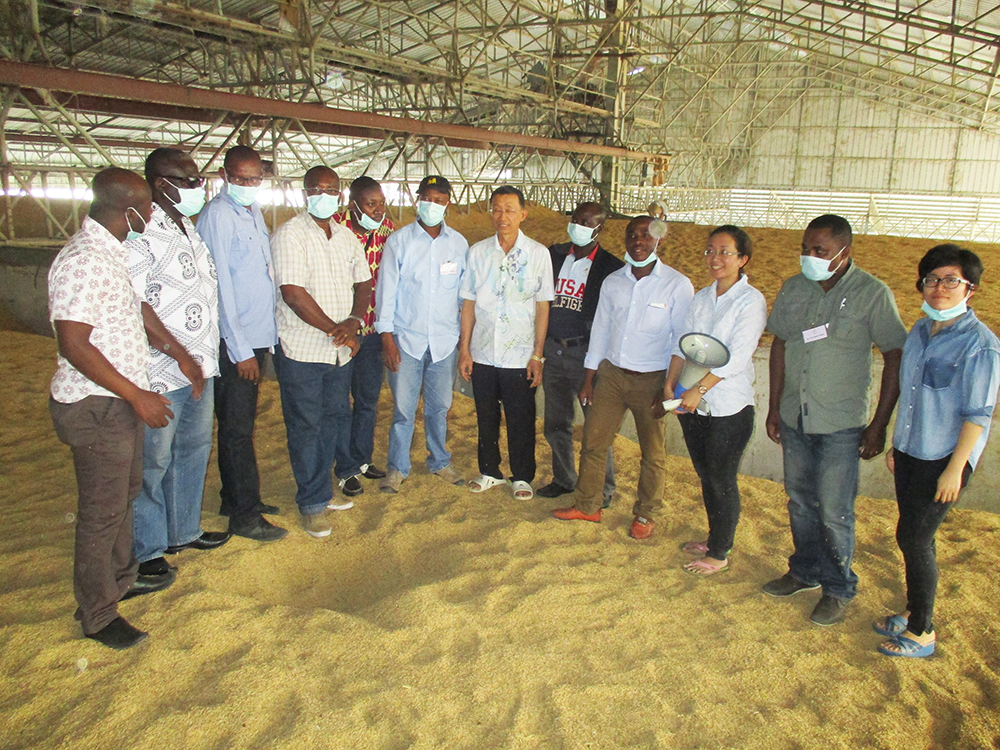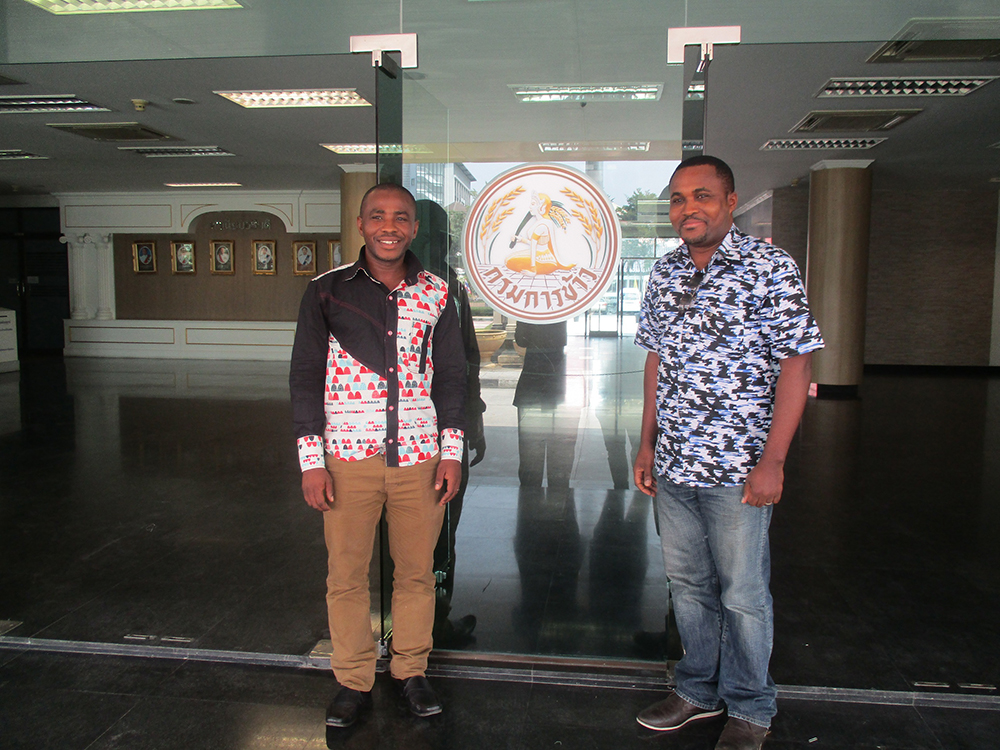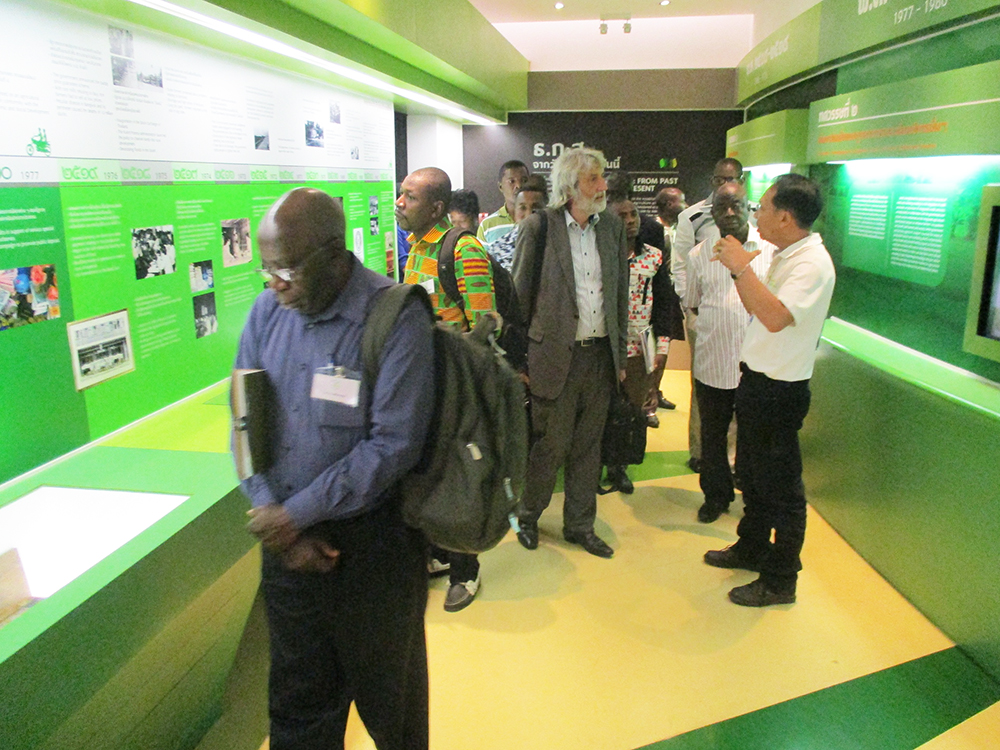
Writer: Kamol T. and Juejan Tangtermthong, based on the report “CARI-BRIA Exchange Visit on Rice Value Chain in Thailand” by Orachos Napasintuwong
Better Rice Initative Asia (BRIA) collaborated with Competitive African Rice Initiative (CARI) to organize a study visit programme on Rice Value Chain in Thailand, on 14-20 February 2016, for project partners from West Africa (WA) to directly learn from stakeholders in the Thai rice value chain, what it takes to be a leader in the global rice industry. BRIA is a sister project of ASEAN Sustainable Agrifood system.

Participating in this visit were 14 professionals selected from Burkina Faso, Ghana, Tanzania and Nigeria, who represent a range of professions from producers, service providers, to workers for government extension and advocacy organizations. They have good knowledge about rice supply chains in their country.
This CARI-BRIA Exchange Programme allowed the stakeholders in the rice value chains in those countries to exchange experience with their Thai counterparts. CARI participants were eager to understand the role of each stakeholder, support from the Thai Government, and rice production system that includes quality improvement, farm mechanization and technology as well as standards.
The participants visited stakeholders in the BRIA project site in Ubon Ratchathani in the Northeast as well as private companies and government agencies in the rice industry in Bangkok including the following:
Baan Umsaeng in Rasisalai District of Sisakhet Province

The participants learned from this self-sustaining farmer group how it manages and controls supplies of organic and Fair Trade rice for export. Registered as a Community Enterprise in 2006 with support from local DOAE (Department of Agricultural Extension), the group consists of 1,250 farmers with 20,075 rai (est. 3200 ha) in rice growing areas. It has its own milling facilities which are also shared with other organic producers in the area. Its jasmine rice is famous and has been granted “Thung Kula Rong-Hai” Geographical Indication under Thailand’s and European Commission’s standards.
The group were keen to learn about comparisons of costs and profit between transpanting and seed broadcasting techniques as they are promoting transplanting to their farmers. They were very interested in the small-scale packing house, agricultural machines and how to make compost.
Det Udom Siri Choke Miller Partnership Ltd., in Ubon Ratchathani Province

This is a private family run mill, currently managed by the 3rd generation. The group were shown around its large compound, which consists of a cold storage warehouse filled with 20,000 tons of paddy with a basic cooling system underneath. They also observed how rice was received with some basic facilities used to reduce field heat. The participants learned about buying mechanisms and rice grades in relation to moisture content. Its 2nd generation owner, Mr. Huangseng Sae Li, is also the president of Ubon Ratchathani Rice Miller Society.
In Thailand, millers buy paddy from local assemblers. Big rice millers pile their stocks during harvest season and keep paddy in the warehouses waiting for purchase orders from central big brokers before they mill it. Exporters are large traders who carry out refining processes and handle wholesale or retail packaging.
Capital Rice Trading
At this top rice exporter of Thailand, the participants toured one of its factories on the outskirts of Bangkok where jasmine rice is processed and loaded into rice barges or ships docking at its own wharf. Capital Rice Co., Ltd, established in 1977 under the STC Group, currently exports rice to Nigeria, South Africa, the Philippines, Indonesia, Malaysia, UAE, Jordan, Spain and France.
Capital Rice buys milled rice from both the Government’s stock and private companies. The company checks rice quality at every step of the process such as before and after loading with fine dusts and stones removed, polishing, separating broken grains, color sorting, grading, etc. The factory operates 24 hours a day, 6 days a week, all year round to fulfill its capacity of 200,000 tons a day. Sixty percent of their rice is to be processed into parboiled rice. Every single package then passes through a metal detector. The participants were impressed by the quality control. Some even recognized retail packages from this factory found in their home countries.
Thai Rice Exporters Association
The Thai Rice Exporters Association (TREA), with 220 exporters as its members, was founded in 1918. This private association plays a vital role in the rice value chain in the country. Together with the Government, the association promotes worldwide recognition of Thai rice and Thailand as the most reliable supplier of quality rice. The association has the vision “to maintain the lead in world-class rice exports for Thailand.”
Participants paid attention to what African rice farmers can learn from Thailand’s experience with market liberalization and international free trade, which have attracted foreign investors and traders with technology and knowledge to the country. For example, in Niger State, NGOs and agribusiness firms are allowed to invest in development projects and farmers can learn from foreign investors. However, significant changes can occur only when the government policies support market liberalization.
TREA obtains a USD 0.5 contribution on every shipment made by its members.
Rice Department (RD)

As a government agency, one of its duties is research and development of rice varieties suitable for growing and eating. Seed production and dissemination is the main duty of the department. Rice cultivation technology generation is also undertaken by 27 Rice Research Centres situated nationwide. Besides, there are 23 Seed Centres located in the major rice producing areas. RD sells certified seeds to private seed producers, agricultural cooperatives as well as the Community Rice Centre (CRC), a registered farmer group, promoted by RD to produce commercial seeds for general farmers. RD is also responsible for farming innovation.
In 2015, RD sold 3,855 tons of seeds to farmers and bought back 4,047 tons of commercial seeds. Since the quantities demanded are greater than the quantites supplied, the private sector satisfies the rest of the market.
Lessons learned:
WA participants had an overall impression that the Thai Government supports the rice supply chain with various programmes. Several public and government-supported institutions consider rice as an important crop, not only for exports but also for improving the livelihood of rice farmers. Rice will continue to be a major crop for the country’s food security reason although it may become less competitive.
The participants felt that free market and free trade are key to develop a competitive rice industry. Allowing more players from production, processing, marketing, and exporting to come into the rice value chain will contribute to a competitive market and farmers will respond to the market demand, supported by relevant institutions.

As Thailand is a major exporter of quality rice, the Government has set clear standards for different types of rice traded on the world market. It is important that stakeholders comply with those standards, especially for quality rice, to produce quality products.
Since financial support is also vital, participants thought that financial institutions are effective to provide services, loans, and programs to rice farmers in Thailand.
Finally, public-private partnerships (PPP) with investment and assistance programmes from the private sector and academia should be promoted to support farmers and augment the Government’s efforts to enable the supply chain to function effectively and promote the rice secor.
Phillips, Fred Odame is an agribusiness and rural development specialist with over 12 years’ experience providing business and technical assistance to agro-based industries. Fred is the Country Coordinator for CARI Ghana implemented by TechnoServe. He commented that the visit created a learning platform to enable exchange of ideas on best practices to improve rice production, marketing and rice based nutrition. He had the opportunity to meet and interact with seasoned experts within the rice industry in Thailand. He gained a better understanding of the BRIA project and would use the lessons learned to improve the CARI programme in Ghana.
Kassim, Suwedi Rajab in Tanzania does farming in Mtunda village, Rufiji District. He faced great challenges from the start due to poor or unavailability of advice and assistance from concerned agricultural related organs and local authorities. Thus, he had to look for literature and the only reliable resource was the internet. He was eager to learn about water management in farms. He expected to apply the lessons learned to his farm and transfer them to local communities.
[su_note note_color=”#d2f6de” radius=”7″]Competitive African Rice Initiative (CARI), BRIA‘s sister project in Africa, is a programme commissioned by Bill and Melinda Gates Foundation (BMGF) and the German Federal Ministry for Economic Cooperation and Development (BMZ) and implemented by GIZ in cooperation with Technoserve, Kilimo Trust, and John A. Kufuor Foundation. Its objective is to significantly improve the livelihoods of rice farmers living on less than 2$ a day in Nigeria, Ghana, Burkina Faso and Tanzania by increasing the competitiveness of domestic rice supply to meet increasing regional demand. In most of West Africa, rice production has not been able to match the increases in demand triggered by population growth, rapid urbanization, increasing incomes and consumers’ preferences in terms of cost and cooking quality. Despite significant increases in rice production, WA still procures half of its rice needs through imports, which account for about 20% of the world’s rice exports. Asia (particularly Thailand, Vietnam, Pakistan, and India) is the major source of these imports. To date, increases in African food production, including rice, have been achieved largely through extending the area under cultivation. Unlike Asian countries, African countries have not invested in developing efficiencies that permit a low-cost rice system. Strategic investments in research & development, production and trade infrastructure and the establishment of an enabling environment that stimulates private sector initiative proceed at a slow pace. [/su_note]